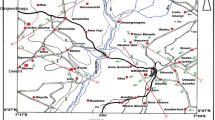Abstract
The subsurface resistivity layer parameters of 47 vertical geoelectrical soundings are analyzed for a rectangle shaped area of 70 km2 from the Gulf of Aqaba coast. For this purpose, the Dar-Zarrouk parameters i.e., (i) total longitudinal unit conductance, (ii) total transverse unit resistance and (iii) average longitudinal resistivity are used to determine the resistivity regime of the water bearing formations. The significance of these parameters is to establish a vision about the occurrence and distribution of water bodies, while dealing with complicated situations of resistivity ranges intermixing for saline, brackish and fresh water aquifers. The results obtained from the study area suggest that the Dar-Zarrouk parameters proved useful in providing confident solution to delineate water-bearing formations. The behavior of the Dar-Zarrouk parameters and its patterns in space over large areas with respect to the occurrence of water aquifer systems in the deltaic coastal area has been demonstrated.










Similar content being viewed by others
References
al Khatib F (1987) The geology of Jabal Al Mubarak & Al Yamaniyya. Map Sheet No. 3048 IV & 2948 I. Geological Mapping Division, Natural Resources Authority, Amman, Jordan
Batayneh AT (2006) Use of electrical resistivity methods for detecting subsurface fresh and saline water and delineating their interfacial configuration: a case study of the eastern Dead Sea coastal aquifers, Jordan. Hydrogeol J 14:1277–1283
Batayneh AT (2009) A hydrogeophysical model of the relationship between geoelectric and hydraulic parameters, central Jordan. J Water Resour Prot 1:400–407
Batayneh AT (2011) Hydrogeophysical investigation of groundwater potential in the southern Amman District, central Jordan. Arab J Sci Eng 36:89–96
Batayneh A, Elawadi E, Al-Arifi N (2010) Use of geoelectrical technique for detecting subsurface fresh and saline water: a case study of the eastern Gulf of Aqaba coastal aquifer, Jordan. J Coast Res 26:1079–1084
Bhattacharya PK, Patra HP (1968) Direct current geoelectrical sounding. Elsevier, Amsterdam, 135 pp
De Breuk W, De Moor G (1969) The water table aquifer in the eastern coastal area of Belgium. Bull Int Assoc Hydrol Sci 14:137–155
de Oliveira Braga AC, Filho WM, Dourado JC (2006) Resistivity (DC) method applied to aquifer protection studies. Braz J Geophys 24:573–581
Ehirim CN, Nwankwo CN (2010) Evaluation of aquifer characteristics and groundwater quality using geoelectric method in Choba, Port Harcourt. Arch Appl Sci Res 2:396–403
Ginsburg A, Levanton A (1976) Determination of salt water interface by electrical resistivity sounding. Hydrological Sciences Bulletin 21:561–568
Habberjam GM (1972) The effect of anisotropy on square array resistivity measurements. Geophys Prospect 20:249–266
Henriet JP (1976) Direct application of the Dar-Zarrouk parameters in ground water surveys. Geophys Prospect 24:344–353
Isife FA, Obasi RA (2012) Electrical anisotropy of crystalline basement/sediment rock around Ifon, south-western Nigeria: implications in geologic mapping and groundwater investigation. ARPN J Eng Appl Sci 7:634–640
Keller GV, Frischknecht FC (1966) Electrical methods in geophysical prospecting. Pergamon Press, Oxford, 519 pp
Maillet R (1947) The fundamental equation of electrical prospecting. Geophysics 12:529–556
Mogren S, Batayneh A, Elawadi E, Al-Bassam A, Ibrahim E, Qaisy S (2011) Aquifer boundaries explored by geoelectrical measurements in the Red Sea coastal plain of Jazan area, Southwest Saudi Arabia. Int J Phys Sci 6:3768–3776
Nwankwo C, Nwosu L, Emujakporue G (2011) Determination of Dar Zarouk parameters for the assessment of groundwater resources potential: case study of Imo State, south eastern Nigeria. J Econ Sustain Dev 2:57–71
Orellana E, Mooney H (1966) Master tables and curves for vertical electrical sounding over layered structures, Interciencia, Madrid, 34 pp
Orellano E (1963) Properties and drawing of so called Dar-Zarrouk curves. Geophysics 28:99–110
Parasnis D (1956) The electrical resistivity of some sulphide and oxide minerals and their ores. Geophys Prospect 4:249–279
Singh UK, Das RK, Hodlur GK (2004) Significance of Dar-Zarrouk parameters in the exploration of quality affected coastal aquifer systems. Environ Geol 45:696–702
Singh KP (2005) Nonlinear estimation of aquifer parameters from surficial resistivity measurements. Hydrology and Earth System Sciences Discussion 2:917–938
Srinivasa Y, Hudson Olivera D, Stanley Raja A, Muthurajb D, Chandrasekara N (2012) Estimation of conductance anomalies in subsurface through Dar- Zarrouk parameters by resistivity inversion method. Int J Phys Math Sci 3:140–151
Urish D, Frohlich R (1990) Surface electrical resistivity in coastal groundwater exploration. Geoexploration 26:267–289
Utom AU, Odoh BI, Okoro AU (2012) Estimation of aquifer transmissivity using Dar Zarrouk parameters derived from surface resistivity measurements: a case history from parts of Enugu Town (Nigeria). J Water Resour Prot 4:993–1000
Van Dam J, Meulenkamp J (1967) Some results of the geoelectrical resistivity method in groundwater investigations in the Netherlands. Geophys Prospect 15:92–115
Watson KA, Barker RD (1999) Differentiating anisotropy and lateral effects using azimuthal resistivity offset Wenner soundings. Geophysics 64(3):1–7
Yechieli Y, Kafri U, Goldman M, Voss C (2001) Factors controlling the configuration of the fresh-saline water interface in the Dead Sea coastal aquifers: synthesis of TDEM surveys and numerical groundwater modeling. Hydrogeol J 9:367–377
Zohdy AR (1965) The auxiliary point method of electrical sounding interpretation, and its relationship to the Dar Zarrouk parameters. Geophysics 30:644–660
Zohdy AR (1974) Use of Dar Zarrouk curves in the interpretation of vertical electrical sounding data. United States Geological Survey Bulletin 1313-D, 41 p 4
Zohdy AR (1989) A new method for automatic interpretation of Schlumberger and Wenner sounding curves. Geophysics 54:245–253
Acknowledgments
This work is supported by the National Plan for Science, Technology and Innovation (NPST) program, King Saud University, Saudi Arabia (Project No. 11-WAT1731-02). The author wish to acknowledge support received from the Natural Resources Authority of Jordan. The two anonymous reviewers and the editorial of JCCO had suggested their constructive comments to improve the article. The authors are thankful to them.
Author information
Authors and Affiliations
Corresponding author
Rights and permissions
About this article
Cite this article
Batayneh, A.T. The estimation and significance of Dar-Zarrouk parameters in the exploration of quality affecting the Gulf of Aqaba coastal aquifer systems. J Coast Conserv 17, 623–635 (2013). https://doi.org/10.1007/s11852-013-0261-4
Received:
Revised:
Accepted:
Published:
Issue Date:
DOI: https://doi.org/10.1007/s11852-013-0261-4




